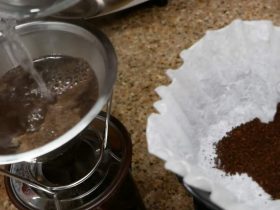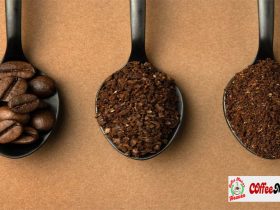Is Coffee Homogeneous or Heterogeneous? Few joys compare to the reassuring ritual of that first cup of coffee in the morning in the midst of our hectic modern life. But underneath this seemingly straightforward beverage’s surface, there is an intriguing mystery: Is coffee really as consistent as it seems, or does it hide a tapestry of complexity? It is not just a matter of scientific investigation to determine whether coffee is a homogenous blend or a heterogeneous concoction, but it is also a voyage that explores cultural, geographical, and sensory spheres. As steam emanates from the mug, so does our enquiring mind about the true composition of this cherished beverage: is it homogeneous in consistency, or is it a varied potpourri of flavors and compounds? The entertaining enigma that swirls within every cup of coffee might be solved by starting this investigation.
What is a Homogeneous and Heterogeneous Mixture?
A homogeneous mixture has uniform composition, with components evenly distributed at a microscopic level (e.g., saltwater). A heterogeneous mixture has visibly distinct components, not evenly distributed (e.g., sand and water). Details below.
Is Coffee a Homogeneous Mixture?
While coffee may seem to be a straightforward and distinct beverage, its ingredients are not fully uniform. A homogeneous mixture has a consistent composition throughout because it is made up of uniform components that are dispersed equally at the molecular level. Although coffee may appear to be a homogeneous beverage, it is actually a complicated mixture of many substances and particles.
Coffee is primarily made up of water, solubilized compounds from coffee beans, and aromatic molecules. However, variations occur due to factors such as the origin of the beans, the roasting process, and the brewing method. Coffee beans from different regions possess distinct chemical compositions, leading to varied flavor profiles. The roasting process further contributes to heterogeneity by altering the levels of compounds responsible for bitterness, acidity, and aroma.
Brewing methods also play a pivotal role. Extraction processes differ based on variables like water temperature, grind size, and contact time, resulting in varying concentrations of soluble compounds. These compounds, such as caffeine, acids, and oils, contribute to the unique taste and texture of each cup.
While commercial coffee brands strive for consistency through meticulous blending and quality control, the inherent diversity in coffee’s origins, roasting, and brewing methods ensures that each cup is a blend of both uniform and heterogeneous elements. In essence, the answer to whether coffee is homogeneous or heterogeneous lies in the intricate interplay between its chemistry, origins, and preparation methods, which together create a beverage that tantalizes our senses with a symphony of flavors while retaining an ever-so-slight touch of delightful unpredictability.
Heterogeneous Mixture?
A heterogeneous mixture refers to a combination of different substances or components that are visibly distinct within the mixture. Unlike homogeneous mixtures, where components are uniformly distributed and not visually separable, in a heterogeneous mixture, the various components remain separate and can be easily identified by sight or simple separation techniques. Examples include suspensions, where solid particles are dispersed in a liquid, colloids that involve small particles suspended in another substance, and emulsions, where two immiscible liquids are combined with the help of an emulsifying agent. The non-uniform nature of heterogeneous mixtures allows for their separation using methods like filtration or decantation, making them valuable in a range of scientific, industrial, and everyday applications.
Definition of Homogeneous Mixtures
You might picture a combination of various components that aren’t quite blended together when you think of a mixture. A homogeneous mixture, on the other hand, is a sort of combination in which the constituents have been blended so thoroughly that it is impossible to distinguish separate substances.
Mixtures that are homogeneous can be either solid, liquid, gas, or plasma. Homogeneous mixtures can be found in things like air, salt water, and metal alloys like steel and brass.
Contrarily, a heterogeneous mixture is one in which the components are not evenly dispersed and where the various components may be seen with the unaided eye, such as in concrete.
Homogeneous mixtures have a number of distinguishing characteristics.
- Since the component ratios are constant throughout the combination, they have a homogeneous makeup.
- Additionally, they are composed consistently, which means that the ratios of their constituent parts remain unchanged over time.
- Furthermore, homogenous mixes frequently have a translucent or transparent appearance and do not settle when they are standing.
Is Black Coffee a Heterogeneous Mixture?
Black coffee, often perceived as a straightforward drink, exhibits characteristics of a heterogeneous mixture due to its varied composition and the processes involved in its creation. While it might appear uniform, black coffee comprises a complex blend of compounds that contribute to its diverse flavor and aroma.
When coffee grounds are steeped in hot water, a process known as extraction occurs. This process involves the dissolution of soluble compounds in the coffee beans, such as caffeine, acids, and oils. These compounds disperse unevenly throughout the liquid, leading to pockets of different concentrations. Additionally, factors like grind size, water temperature, and brew time influence the extraction process, resulting in distinct flavor profiles.
The presence of these non-uniform concentrations and the intricate interplay of compounds make black coffee a heterogeneous mixture. Even within a single cup, slight variations in taste can arise due to the distribution of soluble compounds. This captivating heterogeneity is what makes each cup of black coffee a unique experience, captivating coffee enthusiasts with its range of flavors and nuances.
How are Homogeneous and Heterogeneous Mixtures Different?
Homogeneous and heterogeneous mixtures are distinct in terms of their uniformity and component distribution. A homogeneous mixture, often called a solution, displays a consistent composition throughout, where its components are uniformly and thoroughly mixed at a molecular level. The mixture’s properties remain constant, and its components cannot be visually distinguished. An example is salt dissolved in water, where the salt molecules disperse evenly, resulting in a uniform taste and texture.
In contrast, a heterogeneous mixture comprises visibly different components that are not uniformly distributed. These components maintain their individual identities within the mixture and can be seen with the naked eye or simple tools. A classic example is a mixture of sand and water, where the sand particles settle and can be separated due to unequal distribution.
The key distinction lies in the microscopic and macroscopic uniformity. While homogeneous mixtures possess uniform properties both at a molecular and visible level, heterogeneous mixtures exhibit non-uniformity that’s noticeable to the eye. Understanding these differences is crucial not only for scientific purposes but also for everyday situations where recognizing the nature of a mixture influences how it can be utilized, separated, or transformed.
Conclusion
In the realm of coffee, the question of homogeneity or heterogeneity fades as complexity emerges. Coffee’s chemistry, origins, and preparation methods interlace to create a symphony of flavors. It is both a harmonious blend and a diverse concoction, reminding us that in each sip, we taste the artistry of nature and culture.
Frequently Asked Questions
Why coffee is a homogeneous mixture?
As a mixture of solvent and solutes, coffee is categorized as a particular form of a homogeneous mixture. Since the caffeine in coffee serves as a solute and water serves as the solvent, it can be categorized as a homogeneous solution.
Why is coffee a heterogeneous mixture?
Black coffee just contains boiled water and coffee granules, making it a homogenous mixture. White coffee, however, is typically mixed with sugar, milk, cream, and other ingredients, making it a heterogeneous mixture. But in freshly brewed coffee, the ingredients are thoroughly combined, and each component has an equal amount of each.
What type of substance is coffee?
Caffeine, tannin, fixed oil, carbs, and proteins make up the majority of coffee’s ingredients. It includes 13% proteins, 2-3% proteins, 3-5% tannins, and 10-15% fixed oils. Caffeine is found in the seeds as a chlorogenic acid (CGA) salt. Wax and oil are also present [2].
Why is coffee powder a mixture?
Coffee is regarded as a mixture because it has no predetermined ratios and blends different ingredients like coffee, sugar, milk, or water.
Is sugar in coffee homogeneous?
A spoonful of sugar becomes a solution if it is introduced to a cup of coffee and the solid dissolves. The combination of sugar, coffee, and water is now homogeneous. Supersaturation occurs when the solute concentration exceeds the solvent concentration. Unsaturated: When the concentration of the solute is lower than that of the solvent.

















Leave a Reply